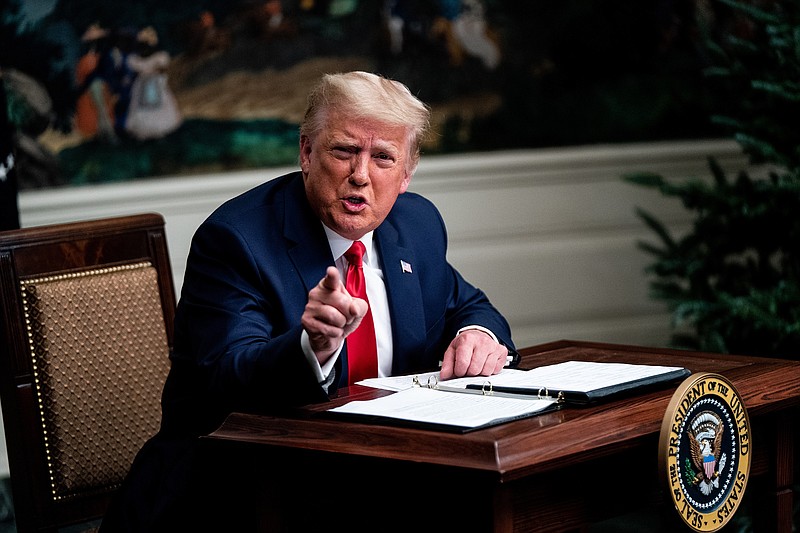Never say never
Forty-five days and some change.
That's how much longer we have to think of Donald J. Trump as our president.
On this page Friday, Tribune columnist Ann McFeatters wrote a long list of Trump horrors and outrages and added: "I am done with this vile man. I will never write an opinion column about Trump again. But we must not forget what corruption looked like in this still young century and how we let down the rest of the world. Trumpism is neither dead nor dormant. We are called to be vigilant."
If we could spell a long, worried whistle, we would write it here.
Suffice it to say that aside from the truth of that "We are called to be vigilant," sentence, we have concern.
We can still see a mother's cocked eyebrow as she eyed her child with all-knowing foreshadowing. "Never say never, dear," she wisely advised. We're often reminded of those words, usually after having forgotten and violated them yet again.
That said, we'll not say we will never write about Trump again. What we can say with certainty is that not writing about him again will never happen.
Oops. Did we say that?
So let's get right to it
If Donald Trump and his supporters in very red states, including Tennessee, want to "stop the steal" from anything, they should focus on Trump himself, who as of Friday has raised $495 million since mid-October.
Nearly half of that, $207.5 million, poured in after Election Day - after he lost and began emailing appeals to supporters to help with his "Election Defense Fund." The appeals used a blast litany of misleading claims about the integrity of the vote.
But in the fine print of these ads and appeals, you'll find a whopping 75% of each contribution to the joint fundraising committee goes first toward the Save America leadership PAC, and the rest would be shared with the party committee to help with the party's operating expenses.
This means that the vast majority of low-dollar donations under the agreement go toward financing the president's new leadership PAC, not to finance voting lawsuits or even to support the GOP.
The contributions, from thousands of grassroots donors across the country, are split into several accounts, including the leadership PAC, which is loosely regulated and could be used to personally benefit Trump even after he leaves the White House. It could even be used to retire Trump's debt that we learned about when his tax returns were leaked earlier this year.
Just to remind us: Those returns showed Trump regularly lost money on most of his properties and he had to personally guarantee $421 million in loans to keep them operating. Most of that debt comes due in coming four years, according to an investigation by The New York Times.
So, donors: Perhaps you should "stop the steal" of 75% of your $495 million in donations to the Save America leadership PAC. With its oft-repeated "Election Defense Fund" and your dollars, you're going a long way toward making Trump solvent. Feel better, now?
When planets conjunct
Let's end with something positive. Something really cool.
This month, the two largest planets in our solar system, Jupiter and Saturn, are coming closer together than they have been since the Middle Ages.
Just in time for Christmas, on Dec. 21, the night of the winter solstice, these planets will appear so closely aligned that they will look like a double planet.
Astronomers call this kind of close approach a conjunction. (And to think, we just thought that was a word to describe other words - like "and," "but" or "if," as they connect random thoughts or sentences.)
But, no, conjunctions of planets, and specifically Jupiter and Saturn, actually occur every 20 or so years, but not like this. Not this close.
"You'd have to go all the way back to just before dawn on March 4, 1226, to see a closer alignment between these objects visible in the night sky," Rice University astronomer and professor of physics and astronomy Patrick Hartigan wrote in a statement. And if you miss it this close encounter, you'll have to live until March 15, 2080, to see another like it.
This time, the two planets have been approaching one another in Earth's sky since the summer, and from Dec. 16-25, they will be separated by less than the diameter of a full moon.
At their closest point, they will be separated by only 1/5th the diameter of the full moon, according to Hartigan. For telescope viewers, each planet and several of their largest moons will be visible in the same field of view. Don't worry about collisions; NASA says that's still hundreds of millions of miles apart.
So just after sunset beginning on Dec. 21, low in the western sky for about an hour each evening, weather permitting, we earthlings will receive a celestial gift to ring in the winter solstice.
How cool is that?
We'll all need some "conjunction" this winter, and it seems the heavens will oblige.
